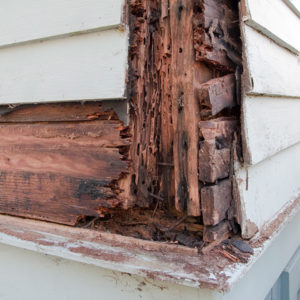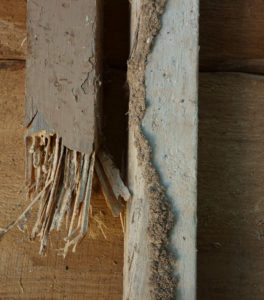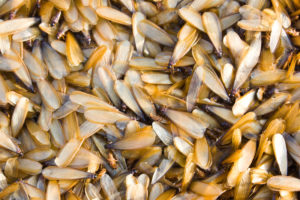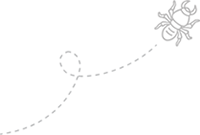What do termites look like?
Termites are small insects typically between ¼ inch and a ½ inch long. Their coloring tends to vary from a light cream color to a reddish-brown. They tend to have soft bodies with much harder heads with strong mandibles they use to gnaw through wood and other materials. While they can be easily mistaken for ants, their bodies are less visibly segmented, and their antennae are straight instead of bent at an angle.
What are early warning signs of termites in my home?
Termites are rarely visible outside of their colonies or feeding grounds. When you do see termites coming out of the ground, it’s usually swarmers, winged termites looking to start a new colony. They typically come out during daylight or early evening hours. Even if you don’t see the actual swarming, they still leave behind signs of their activities, including wings or dead bodies on windowsills.
When you can’t find swarmer evidence, you can still find mud tunnels. These are created with saliva, wood waste, and soil and connect their subterranean colonies with their feeding areas inside your home or business. You can usually see them inside cracks in brick or concrete, but free-standing ones c an often be found in crawlspaces.
an often be found in crawlspaces.
Even without visible signs, there are still some other ways to check for termite presence. Termites consume wood from the inside out, leaving hollow areas in the middle. When you suspect that there may be termites in your home, try to find out by knocking on wood. If it feels soft and gives off a hollow sound, then the chances of their presence are high. To pinpoint this problem with precision, though, we recommend calling an expert because their knowledge will help narrow down if you genuinely have a termite problem.
What do termite tunnels look like?
As mentioned above, termite tunnels or mud tubes are one of the most evident signs of termite infestation, so recognizing a termite tunnel can be very useful in determining whether or not to take action. Generally, there are four different types of mud tubes that you might see.
The first is an exploratory tube. These are thin and tend to spread out in multiple directions. They are made of dirt, termite feces, also known as frass, and saliva. They’ve been known to stretch as much as fifteen feet above the ground on metal or concrete surfaces. Thicker, free-standing exploratory tubes exist as well.
The second type of tube is a working, utility, or shelter tube. This is the busiest tube in a termite nest as it directly links the colony itself with its food supply. They help keep termites safe from harm as they go about their daily business. These tubes are usually between a ¼ inch and a full inch in diameter. While they’re built of the same materials as exploratory tubes, they are much sturdier and last much longer. They can often be found beneath home foundations and in basement walls but can be seen squeezing through all sorts of gaps and entrances to the home with ready access to cellulose-rich materials.
 The third kind of tube, the drop tube, is among the most easily identifiable types of mud tube as they tend to look like cave stalagmites. Unlike other termite tubes, they aren’t built into the walls but extend from a feeding area straight down to the ground.
The third kind of tube, the drop tube, is among the most easily identifiable types of mud tube as they tend to look like cave stalagmites. Unlike other termite tubes, they aren’t built into the walls but extend from a feeding area straight down to the ground.
The last kind of mud tunnel is known as a “Swarm Castle.” It functions as a launching pad for termite swarmers before they leave the colony to found new ones. Usually, these aren’t so much tubes as a wide, hollow mud lump. The wood beneath it is kept especially smooth to accommodate swarmers’ fragile wings, which could be torn off by the jagged edges found in most termite feeding areas. They congregate in these swarm castles until the environment is just right to take off and begin exploring for fertile new termite territory. These castles are usually quite visible and one of the most obvious signs of a termite infestation.
To learn more, visit our mud tunnel page.
What happens during a termite inspection?
When inspecting your home, a pest control professional will perform several tests to check for the presence of termites or other wood-destroying insects. Viking technicians will look for evidence of infestation around, within, and beneath your home. They’ll check cracks in walls or floors; sagging door frames with missing panels–anything to indicate an area where pests could enter easily. No detail will be ignored, be it the area under the soffits and fascia of your roof, the crawl space under your home, or the baseboards along the wall in the search for any evidence of nesting or damage. They will bring various specialized tools to the job to see and hear what is happening in your home.
Do black termites exist? What are they?
Termites are usually white, yellow, or reddish-brown in color. However, black termite swarmers most definitely exist, and since swarmers are the most frequently seen termites, it makes the sight of black termite swarmers among the most commonly kind of termite sighting. This is one of the reasons they can be mistaken for ants, as black is also by far one of their most common colors.
Do termites have wings?
Some termites do. Specifically, breeding termites known as alates or swarmers will take flight to look for places to breed and begin new colonies. When they reach the end of their journey, they shed their wings. One common sign of a termite infestation is the presence of discarded termite swarmer wings.
How far do termites fly?
Under their own power, termite swarmers can’t fly terribly far, perhaps 200 (~656 feet) meters at most. However, under extreme wind conditions, they have been measured to fly more than 6000 meters, which is nearly four miles!
Do termites bite?
Termite bites are extraordinarily rare, and when bites do occur, they aren’t a danger to people. If you do get bitten, it is most likely to be by a soldier termite. But since soldier termites are rarely seen outside of feeding or breeding areas, it’s unlikely for you to encounter one, let alone be bitten.
How do I tell the difference between ants and termites?
Termites have two segmented bodies consisting of a head and thorax. Ants have three-segmented bodies with a head, a thorax, and an abdomen. These segments are also far more pronounced on ants giving them a distinctive, bulbous shape, whereas termites are more rectangular overall. Termite antennae are straight, whereas ant antennae are bent at a sharp angle. Termite swarmers, the flying reproductive termites you are most likely to see above ground, have four equally sized wings, which they shed. Flying ants have four wings, but they come in two different sizes, with the front wings being larger than the back wings, and they do not shed them.
Does mulch attract termites?
Mulch doesn’t attract termites by itself as they rarely eat it despite being made of wood. However, mulch helps to keep the environment around your house moist, and termites love moisture. As mulch is often placed directly around the house and increases the moisture in the soil, it creates a more welcoming environment for termites to take root. Of course, the purpose of mulch is to provide that very moisture. This is one of the reasons why termite prevention and soil maintenance are actions that must go hand-in-hand to provide your home with the maximum benefit while minimizing potential termite damage.
Do termites eat drywall?
Short answer: Yes. Drywall is made of plaster, which termites don’t eat, but it’s enclosed on both sides with paperboard, which is partially composed of cellulose. Termites eat the cellulose found in the paperboard inside the drywall. They will also eat the cellulose in other forms of paper, from cardboard to books.












